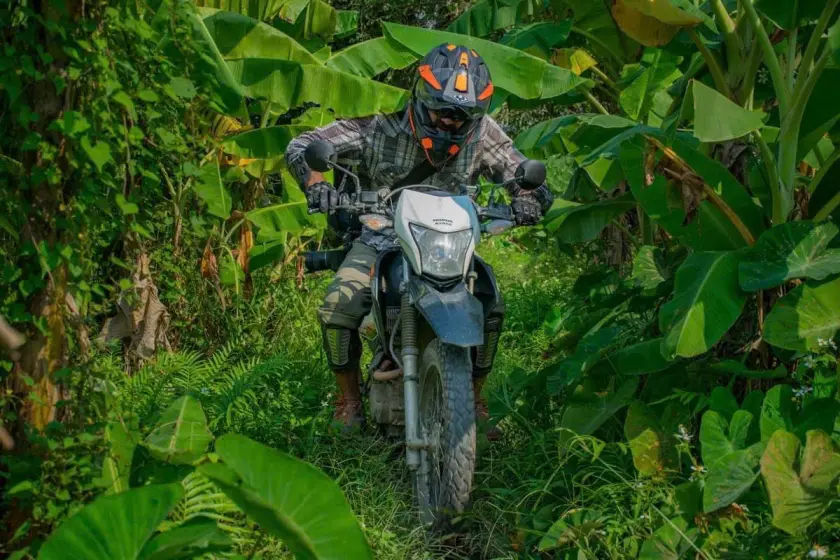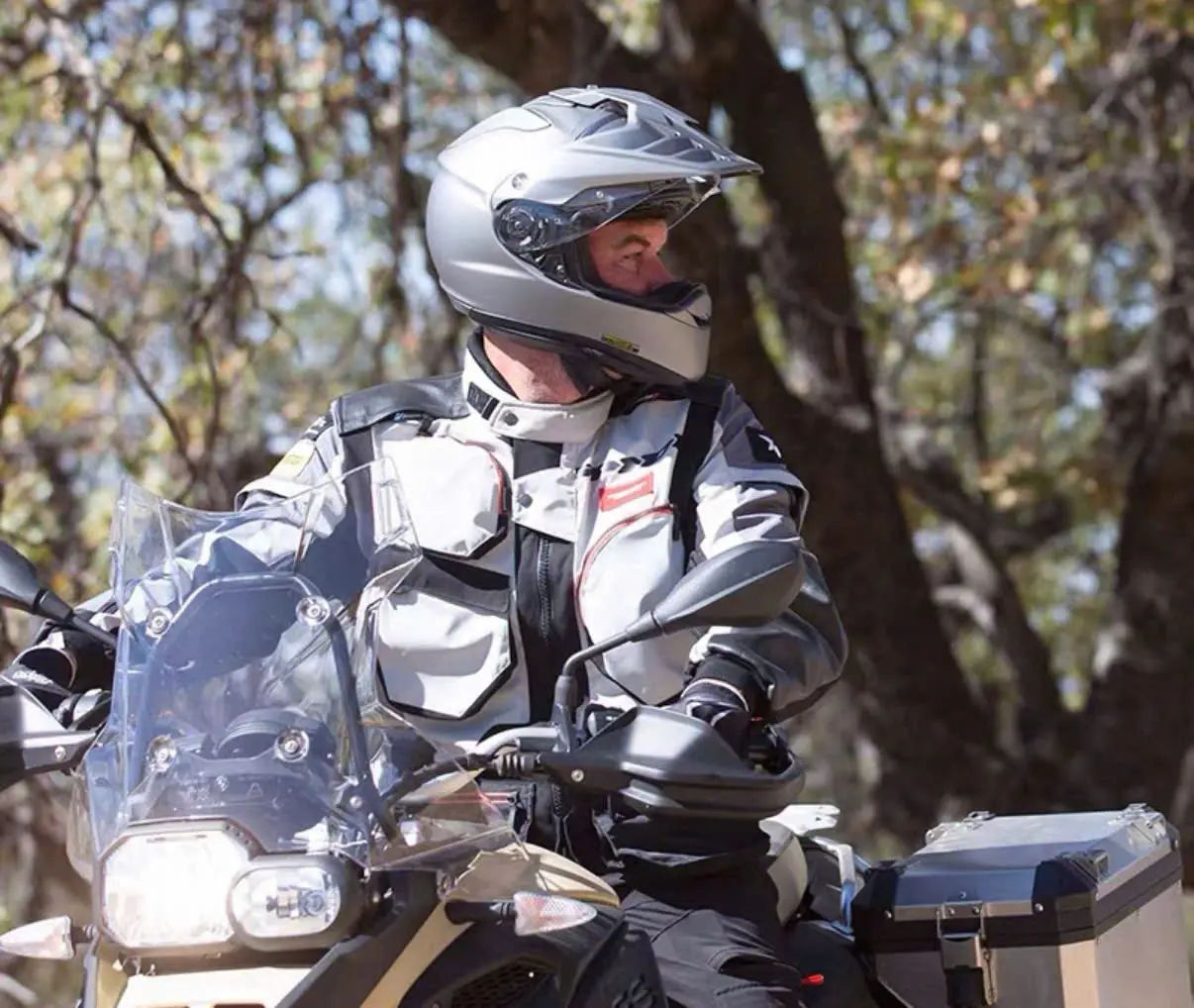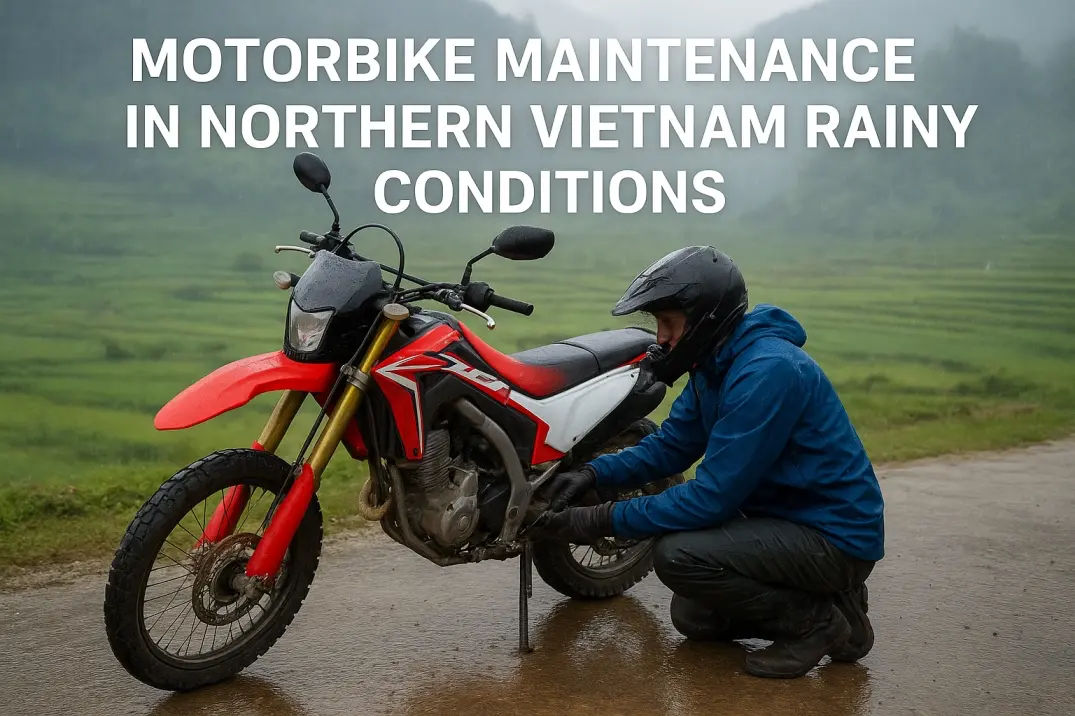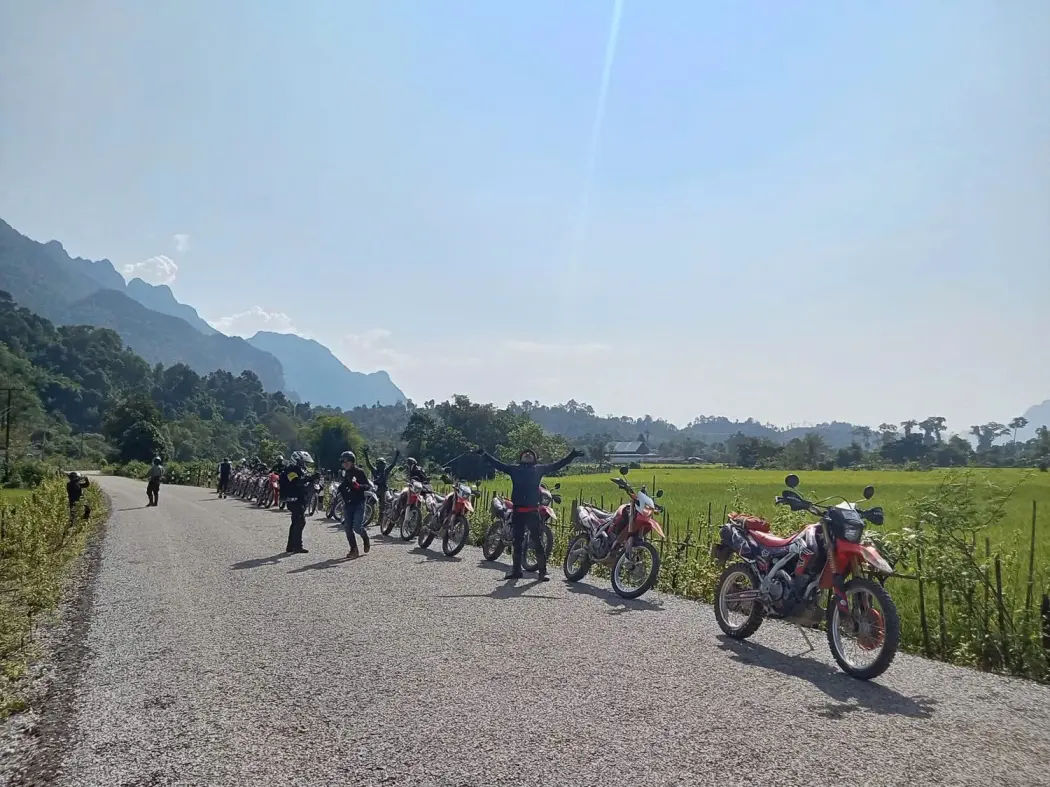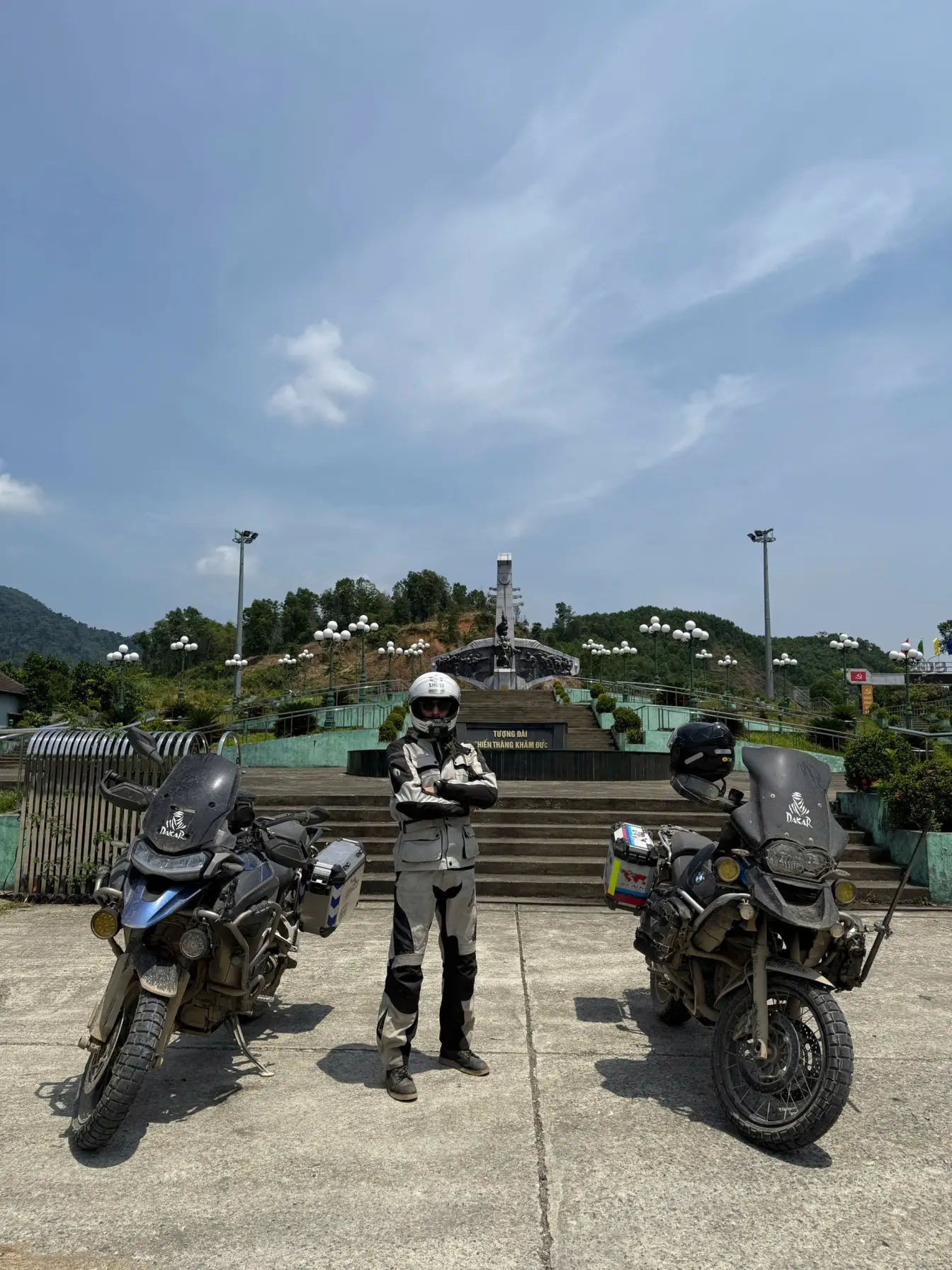
Wet roads, muddy trails, and constant moisture can wear down even the best brands of motorbikes, especially if you’re on a long-haul journey from Hanoi up to Ha Giang or Sapa. Staying on top of basic maintenance not only keeps your motorbike running smoothly but also keeps you safe on slippery mountain roads. No matter how experienced you are, or even if it’s your first time ride renting in Hanoi or a long-term traveler tackling Vietnam’s northern loop, knowing how to care for your bike in wet conditions will make all the difference between an unforgettable adventure and a frustrating breakdown by the roadside. In this post, I share tips for riding a motorcycle in the rainy season, let’s go
- Check out Best Vietnam motorbike tours
Motorbike Maintenance in Northern Vietnam Rainy Conditions: Introduction
Riding a motorbike through Northern Vietnam’s rainy season is a mix of awe and challenge, im talking about those riders who are into challenge and off-road and riding for long hours. The kind of journey that tests both your spirit and the motorcycle.
But behind the beauty of the any mountain ride, lies a hard truth: rain changes everything about the way your bike behaves. Moisture seeps into the brakes, chain, and wiring, while endless humidity takes its toll on even well-maintained engines. Proper maintenance becomes more than routine, it’s survival. In wet weather, your stopping distance can increase by up to 25 percent, making reliable brakes essential when navigating steep descents or sudden curves.
Without regular checks, a loose chain or worn tire can quickly turn a scenic ride into a dangerous situation. Taking care of your bike in these conditions isn’t just mechanical know-how it’s respect for the unpredictable rhythm of Northern Vietnam’s roads and the wild weather that defines them.
- Check out Alternatives to Ha Giang Loop routes
How Rain Affects Your Motorbike’s Performance
If you’ve spent any time riding through Northern Vietnam during the rainy months of May to September, you’ll know how quickly the weather can turn against you. One minute you’re cruising comfortably, and the next you’re sliding through puddles with your visibility cut in half.
Rain doesn’t just make riding uncomfortable, it changes how your motorbike performs. Wet roads mean less grip, longer braking distances, and more wear on your moving parts. Moisture also creeps into areas you can’t always see, slowly affecting your bike’s reliability. Understanding how rain impacts each part of your motorbike helps you stay ahead of the problems before they leave you stranded on a mountain road.
- Explore Ha Giang loop by motorbike
Impact on Brakes, Tires, and Chain
Brakes, tires, and the chain take the hardest hit when the rain stars. Wet surfaces reduce traction, which means it takes longer to stop, sometimes up to 25 percent more distance than on dry roads. If your brake pads are worn or your tires have shallow tread, that extra distance can make a big difference on a downhill bend.
The chain also suffers in constant rain; it picks up grit and mud, wearing down faster if not cleaned and oiled regularly. I’ve learned the hard way that skipping a post-ride chain wipe-down often leads to rust or that unpleasant squeak that only gets worse the longer you ignore it.
- Check out Sapa motorcycle loop
Electrical and Battery Issues in Wet Conditions
Look, im not trying to scar you guys by writing all these tips, t’s a general advices and these all are based on my own experience riding in Vietnam’s unpredictable climate for more than a decade.
Northern Vietnam’s humidity is brutal on a motorbike’s electrical system. Water finds its way into switches, connectors, and spark plugs, leading to random misfires or a bike that just won’t start one morning.
Even a simple wash after a muddy ride can cause issues if you’re not careful. The battery is especially vulnerable poor insulation or loose connections can drain it faster in wet weather. Keeping the terminals clean and checking for corrosion becomes part of the daily routine. A quick inspection before each ride can save you from being stuck halfway to Ha Giang with a dead battery and no mechanic in sight.
Rust and Corrosion Problems from Constant Moisture
Moisture never really leaves your bike during the rainy season, it clings to every bolt, nut, and cable. Over time, that constant dampness causes rust, especially on exposed metal parts like the exhaust, frame, and chain. I’ve seen riders lose the shine on their bikes in just a few weeks up north.
A thin coat of anti-rust spray or even a wipe-down after each ride goes a long way. It’s a small effort that keeps your bike looking and running well, even when the weather refuses to cooperate. Regular care might not make the rain stop, but it will make every wet ride a lot less stressful.
Essential Maintenance Tips for Rainy Conditions
Riding through Northern Vietnam’s rainy months teaches you one thing fast — your motorbike only treats you as well as you treat it. Daily maintenance isn’t optional; it’s what keeps you safe and moving when the rain won’t let up. Small habits, like wiping your bike after a ride or checking your chain tension, can make all the difference on slippery, unpredictable roads. Here are a few practical steps that come straight from the road — the kind of advice you only pick up after a few soaked rides and roadside repairs.
Regular Cleaning and Drying After Rides
After a wet ride, resist the urge to just park your bike and call it a day. Rainwater mixed with dirt and road grime sticks to every part of your bike and starts causing corrosion before you even realize it.
I’ve found that a quick rinse and a thorough dry, especially around the brakes, chain, and under the seat, keeps problems from building up. Use a soft cloth or compressed air to dry out tight spots, and don’t forget the footpegs and control levers. It might feel like a chore after a long day’s ride, but it’s the easiest way to extend your bike’s lifespan in humid, muddy conditions.
Proper Chain Lubrication and Tire Check
Your chain and tires take the brunt of Vietnam’s wet roads. Water washes away chain lube fast, leaving it dry and exposed to rust. I learned early on that re-lubing after every rainy ride saves you from that grinding noise that shows up after a few days of neglect.
A good-quality chain lube with water resistance goes a long way here. As for tires, check the tread and pressure before each ride, even a small loss of traction can turn into a slide on slick pavement. If your tires are getting smooth, don’t risk it; new rubber is cheaper than a crash on a mountain descent.
Waterproofing Electrical Components
Vietnam’s constant rain and humidity are brutal on electrical parts. Water sneaks into switches, fuse boxes, and connectors, leading to random stalls or flickering lights.
One trick I picked up from local mechanics is to apply a bit of dielectric grease to plug connections, it keeps moisture out and current flowing smoothly. Wrapping vulnerable wires with electrical tape or using small waterproof covers on the battery terminals also helps. These small steps can prevent a lot of headaches, especially when you’re far from a repair shop.
A little waterproofing before your trip means fewer surprises when the rain inevitably catches up with you.
Preparing Your Motorbike for Long Rainy Trips
If you’re planning a long motorbike trip through Vietnam’s Northern Territory, during the rainy season, preparation is everything.
The rain here isn’t just a passing shower, it can last for couple of hours on daily basis, soaking you and your bike from morning to night. I’ve learned that a well-prepared bike can make the difference between a smooth journey and a miserable breakdown on the side of a slippery mountain road. Taking the time to inspect, pack smart, and equip yourself properly before hitting the road will keep both you and your motorbike ready for whatever the weather throws your way.
Pre-Ride Inspection Checklist
Before setting off, always give your motorbike a thorough check. Start with the basics like brakes, tire tread, oil levels, and lights. If you can’t do it yourself (not everyone is a de-facto mechanic), you can ask a mechanic to do it and it won’t cost much at all (USD 2-3 for a quick check up, sometimes FREE)
Make sure the brake pads aren’t worn down, and that your tires still have deep grooves for proper grip on wet roads. Check your chain tension and ensure it’s well-lubricated; a loose or dry chain won’t last long in the rain.
Don’t skip the battery and wiring, look for exposed or corroded connectors that could short out when wet. I’ve made it a habit to run through this checklist every morning before riding in the rain, and it’s saved me from countless roadside headaches.
Recommended Tools and Cleaning Products
Carrying the right tools and cleaning gear is a game changer during Vietnam’s rainy season. At the very least, bring a compact toolkit with Allen keys, a chain brush, and a small can of chain lube.
Add a microfiber cloth or two you’ll use them more than you expect for wiping down wet parts after a ride. A small bottle of anti-rust spray can keep your bike from aging fast in humid conditions. I also keep a folding brush and biodegradable cleaner to wash off mud without needing a hose. These small additions don’t take up much space but can save you from bigger maintenance problems later.
Packing Essentials for Wet Weather
When it comes to packing for long rides in the rain, waterproofing is your best friend. Start with proper rain gear, a full rain suit, waterproof gloves, and boot covers.
For your bags, invest in dry sacks or waterproof panniers; plastic bags alone won’t survive heavy downpours. I always pack an extra set of dry clothes sealed in a compression bag, it’s a small comfort that makes a huge difference after a long, wet day. Keep a few microfiber towels handy for quick wipes and a small tarp to cover your bike overnight.
Staying dry isn’t just about comfort; it helps you stay focused and ready for the next leg of the ride.
Safety Tips for Riding in the Rain
Riding in the rain across Vietnam isn’t for the impatient or unprepared. Wet roads demand extra focus, smoother control, and more respect for your surroundings. Even experienced riders can get caught off guard by sudden downpours, slippery corners, or patches of hidden mud.
Over the years, I’ve learned that staying safe in wet weather isn’t just about riding slower, it’s about anticipating how your bike and the road react under changing conditions. With the right habits and gear, you can handle the rain confidently instead of fighting against it.
Adjusting Speed and Braking Distance
When it comes to big motorcycle tours, people often think we drive insane and rev up like moto GP, well no. We ride on moderate speed and one of the first things you notice riding in the rain is how much longer it takes to stop.
Wet surfaces can reduce your grip dramatically, meaning your stopping distance can increase by up to 25 percent or more. I learned early on that braking hard or suddenly in these conditions is a recipe for sliding.
Instead, slow down gradually and give yourself plenty of space between you and the vehicle ahead. Use both brakes gently and evenly, keeping your throttle movements smooth. Avoid riding over paint lines or metal surfaces, as they become extremely slick when wet. Riding in the rain isn’t about rushing, it’s about control and patience.
Choosing the Right Tires for Wet Roads
Your tires are the only thing connecting you to the road, and in the rain, they become your lifeline. Choosing tires with deeper tread patterns and good water dispersion makes a huge difference. I once tried to ride through a downpour on worn tires, never again.
The lack of grip made every corner feel like a gamble. For Northern Vietnam’s unpredictable terrain, dual-purpose or rain-rated tires are ideal. Keep an eye on air pressure, too; slightly lower pressure can increase traction, but don’t overdo it. Investing in good-quality tires isn’t a luxury here, it’s one of the best safety decisions you can make.
Maintaining Visibility and Helmet Care
In heavy rain, seeing clearly becomes half the battle. Water, fog, and glare from oncoming traffic can quickly reduce visibility. A clear, anti-fog visor is worth its weight in gold. I always carry a small bottle of visor cleaner and a microfiber cloth to keep mine smudge-free. Some riders even apply a thin layer of dish soap or anti-fog spray inside the visor for better clarity.
Make sure your helmet’s ventilation system works properly to prevent misting, and never ride with the visor cracked too wide, rainwater finds its way in fast. After each ride, dry your helmet thoroughly, especially the padding, to prevent mold and that damp, musty smell no rider likes.
Where to Service or Repair Motorbikes in Northern Vietnam
If you’re riding through Vietnam, specifically in the north, chances are your motorbike will need a bit of attention along the way, especially in rainy conditions.
The constant moisture, mud, and rough terrain can wear down parts faster than you’d expect. Knowing where to get repairs or who to trust with your bike becomes just as important as knowing how to ride. After countless trips through Ha Giang, Sapa, and Cao Bang, I’ve learned that the best mechanics aren’t always the ones with fancy signs, they’re often the small, roadside workshops run by people who’ve been fixing bikes for decades.
Whether it’s a full service or a quick patch-up job, understanding where and how to get help on the road can save your trip from turning into a long walk in the rain.
Trusted Local Repair Shops in Ha Giang, Sapa, and Cao Bang
In the north, local repair shops are everywhere, but a few stand out for their reliability and experience with bigger motorcycles, the high displacement rides we are talking about.
If you ride a scooter and small motorbikes, there is nothing to worry about, mechanics are everywhere and they all know how to fix your bike in a blink of an eye.
In Ha Giang, or Sapa, or generally around the front-line, you’ll find solid mechanics near the main loop routes who understand rental bikes like the Honda XR or CRF models, they know exactly what breaks and how to fix it fast.
In Sapa, head toward the bus station area; several small garages there are familiar with tourist traffic and can handle everything from brake pad changes to tire replacements.
Cao Bang is a bit quieter, but look for shops near the city center or along the road to Ban Gioc Waterfall, they often double as family homes and workshops. What I’ve learned from locals is this: don’t be afraid to stop and ask. Most northern mechanics might not speak much English, but they’ll get your bike back on the road with impressive skill and speed.
- Comparison: Ha Giang VS Cao Bang Loop
Emergency Fixes You Can Do on the Road
When you’re far from town and something goes wrong, a few simple fixes can keep you moving until you reach the next mechanic. I always carry a small roadside repair kit, a multi-tool, zip ties, duct tape, and a compact air pump.
For chain problems, a quick clean and a splash of chain lube can make a huge difference. If your brake lever feels loose, tighten it carefully using basic tools; if your spark plug gets wet, remove it, dry it, and reattach firmly. Even small tricks like using a plastic bag to cover exposed wires or cleaning mud from your brake pads can prevent bigger issues.
Out here, being able to handle a few quick repairs yourself isn’t about showing off it’s about making sure you reach your next stop safely, even when the rain won’t let up.
Conclusion: Tips For Riding A Motorcycle In The Rain
Riding in the rainy season can test both your patience and your motorbike, but with the right care and habits, it’s more than manageable, it’s just an amazing experience.
Rain, mud, and humidity may wear down your bike faster, but consistent maintenance keeps you one step ahead of the weather. Check your brakes, clean your chain, dry your bike after every ride, and pay attention to the small details that keep it performing smoothly. I’ve learned that taking ten minutes at the end of a wet day to inspect and clean makes the next morning’s ride a lot easier.
Keep Your Ride Smooth: Mastering Motorbike Maintenance in Vietnam’s Rainy Season isn’t about perfection, it’s about preparation. The riders who stay safe and enjoy the journey aren’t the ones with the newest bikes, but the ones who understand their machines and take care of them, no matter the weather. If you treat your motorbike with respect, it will carry you through the rain, up the mountain roads, and into the next story waiting just around the bend.
FAQs: How to Prepare Your Motorcycle for the Rainy Season
How often should I clean my motorbike during the rainy season in Vietnam?
Clean and dry your bike after every ride. Rainwater mixed with dirt and mud causes rust fast, especially on the chain and brakes. A quick rinse and wipe-down prevent long-term damage.
What’s the best lubricant for wet conditions?
Use a water-resistant chain lube or O-ring safe lubricant designed for rain and humidity. Brands like Motul, Liqui Moly, or Repsol perform well in Vietnam’s wet climate. Local mechanic often use motor oil as a lubricant.
Can I use regular tires in rainy weather?
You can, only if the ride is on the road, for off-road, it’s not ideal. Regular tires lose grip faster on wet roads. Use rain or dual-purpose tires with deeper tread for better traction and safety.
How can I protect my motorbike’s electrical system from rain?
Apply dielectric grease to plugs and connectors, wrap exposed wires with electrical tape, and keep battery terminals clean and dry. Avoid washing the bike with high-pressure water near the wiring.
Where can I find reliable motorbike maintenance services in Northern Vietnam?
In the north, look for trusted mechanics in Ha Giang, Sapa, or Cao Bang. Most local repair shops along the main routes handle rain-related issues daily and are familiar with traveler bikes.
About the Author
Hamid is a long-distance rider who has explored Vietnam’s northern regions through every kind of weather. With years of experience maintaining his own bike on the road, he shares practical tips for travelers who want to keep their motorbikes running smoothly rain or shine.




